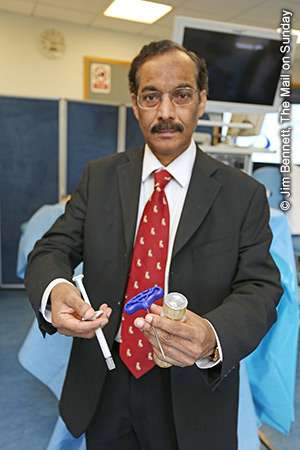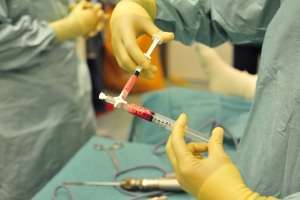Professor Anan Shetty
A pioneering technique that uses a patient's own stem cells to regrow bone, heal fractures and prevent amputation has been developed by a Canterbury Christ Church University Professor.
Professor Anan Shetty, Deputy Director of Minimally Invasive Surgery at the University's Medway Campus, has spent ten years, collaborating with Professor Seok-Jung Kim, Catholic University, South Korea, developing the procedure, as well as a special gel to give signals to stem cells to start regeneration.
The process includes collecting bone marrow from a patient's pelvis, isolating the stem cells them through a centrifuge machine using a fast spinning motion and mixing them with the specially prepared collagen gel. This mixture is then injected into the fracture site of the bone using minimally invasive surgery. The stem cells regenerate and grow as new bone over a period of time connecting the unhealed fracture.
Professor Shetty explained: "Each year, about 350,000 patients are admitted for fracture treatment in England and Wales. 5-10% of these fractures just do not heal because the break is too bad, the gap between the bones is more than two centimeters, it becomes infected or because of poor blood supply. These cases usually require multiple surgical procedures, and occasionally, amputation of the limb."
"We know that we can grow almost any part of the body using stem cells, as they are essentially 'blank smart cells'. However, stem cells need a signal to start that regenerative process and form a particular type of tissue like bone or cartilage. The difficulty with stem cell implantation into a fracture site is that bone does not have the chemical signals required for this to happen.
"It took five years to develop a special collagen gel that when mixed with the harvested stem cells, prior to injecting into the site of the fracture, will give them a signal to start regenerating and grow as new bone to heal the fracture."
The operation, performed under a general anesthetic, with minimally invasive technique, takes about 30 minutes and the patient is able to go home on the same day.
In the case of a leg fracture a metal rod is still inserted in to the bone, to stabilise the leg whilst the new bone grows, but this is also done with a minimally invasive procedure via a small incision just below the knee which allows access to the top of the tibia.
The specially developed collagen gel and stem cells being mixed prior to injection into the fracture site
The stem cells and collagen gel mixture is then injected into the fracture site and around the bone, under X-ray guidance.
Professor Shetty continued: "The traditional medical options available to try to heal these types of unhealed fractures are very complicated, using bone and skin grafts, and metal cages with pins and bolts through the leg. Patients can be in a lot of pain and it can take months, even years, to try to heal the break and even then the only option that is normally left for the patient if the fracture doesn't heal is amputation.
"This new procedure is simple and minimally invasive compared to traditional techniques. Patients are able to walk almost immediately after the operation and the recovery time almost half of that compared to the traditional method. The whole procedure costs about £3,000, which is considerably less than the hundreds of thousands of pounds it costs for amputation, prosthetics and ongoing care; the traditional options currently available.
"At the moment, this procedure is only being used for those complicated fractures that won't heal, but there is no reason why this technique cannot be used for all fractures in the future and reduce the time needed for healing."
To date, Professor Shetty has carried out the new procedure on six patients in the UK, four in India and 20 in South Korea with Professor Kim, with a 95% success rate. One of those patients is Clive Randell from Kent, who after nearly two years of suffering extreme pain and numerous procedures in an attempt to heal a broken leg after a motorbike accident, was faced with the only option left: amputation.
Clive explained: "In 2011 I was knocked off my bike. Despite all my years of bike riding I had never been involved in an accident that required hospital treatment. I thought, 'It's just a broken leg, I'll be fixed and on my bike again in no time'. However, the break was complicated and the bones would not fuse.
"Over the next 15 months I endured three bone grafts, my leg was in a cage, with bolts and screws through it and I had to tighten manually to keep the leg straight. At one point my skin was stretched over the cage so that it would eventually cover the wound. I even got life threatening blood clots on my lungs because of the situation. The pain at times was unbearable, I lost my job, I felt useless and mentally I struggled to keep positive throughout it all, but as long as there was a chance to save my leg I was prepared to go through anything.
"Eventually, the consultant explained to me that there were a few more options they could use, but realistically I was facing the prospect of having to have my leg amputated. They asked if I needed a few minutes to think about what I wanted to do. Instead, I went home and searched on the internet 'How to save my leg'.
"As if by magic Professor Shetty's name and work appeared. I emailed him and coincidentally he was in the same hospital not far from my original consultant. When we met Professor Shetty said he could save my leg. I couldn't believe it but by this point I was prepared to try anything and I put my faith in him.
"When I came out of the operation, Professor Shetty asked me to stand on my leg, which completely shocked me and to be honest scared me, because I had spent nearly two years unable to put any weight on that leg. But he was determined, and so I did as he asked, and to my surprise the leg didn't buckle. I was home within hours and walking within weeks.
"I just can't believe after everything I went through, not only do I still have my leg, but I can now walk. I won't be running the marathon anytime soon, and I am not able to go back to my old job, but I feel like I have my life back. And most importantly I am able ride bikes again – although Professor Shetty is not very impressed with that bit!
"My hope is this procedure will eventually be available to everyone, since it can help so many people, particularly the military.
"The old way of mending broken bones is so painful and stops you getting on with your life.
"Professor Shetty's stem cell surgery is quick and almost painless, and it's important more people hear about it."
Provided by Canterbury Christ Church University






















